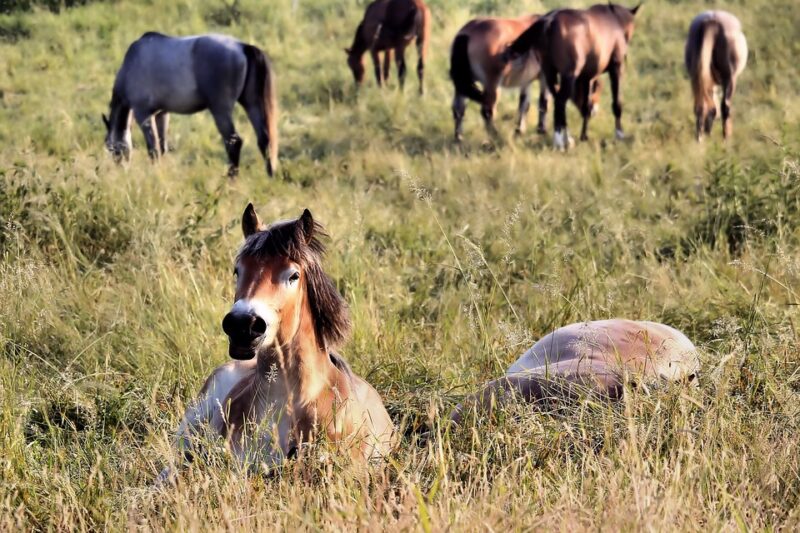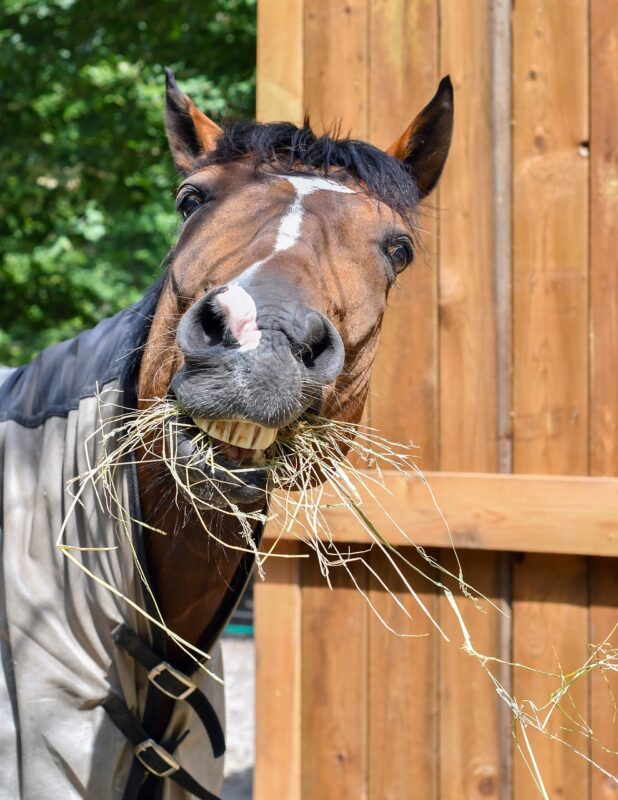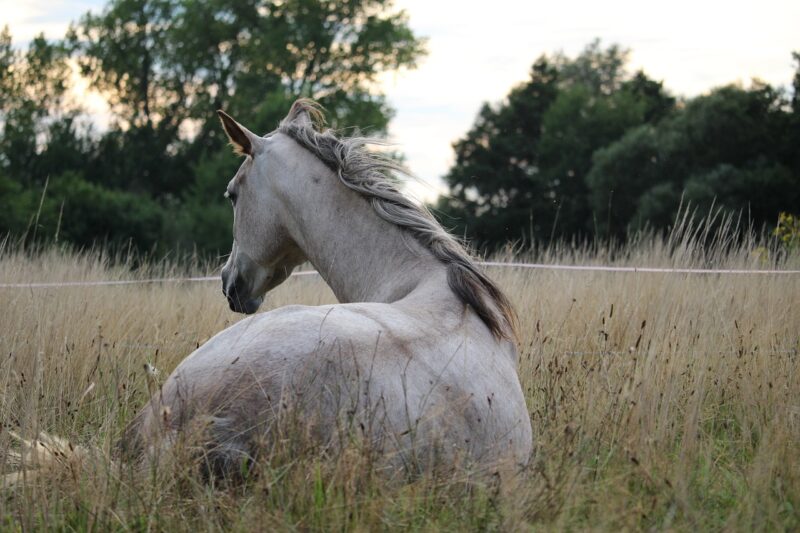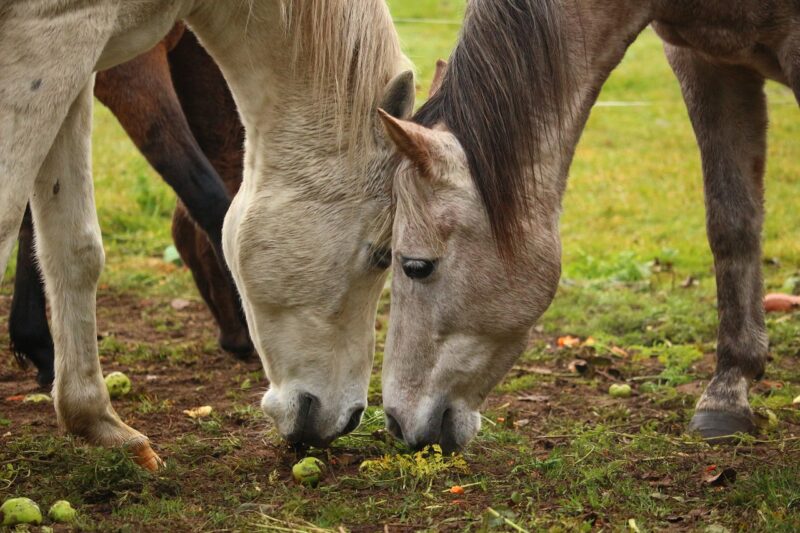Enriching Equines believes in behavior first: when designing enrichment, working out problems between horse and rider, and thinking of ways to improve your horse’s lifestyle, behavior-based equine enrichment is the best way to meet your goals.
Behavior First
What is “behavior first,” and what does this mean for you and your horse’s enrichment experience?
It means that the best way to plan and provide enrichment to your horse – the enrichment that provides mental stimulation, physical activity, and improves welfare – is to follow a behavior-based equine enrichment strategy.

Enrichment is the process or techniques you use to give your horse the chance to behave naturally. It can be anything from toys and treat feeders to new pasture “furniture” to special activities and training. Because enrichment is meant to promote and encourage behavior, it makes sense to plan and develop your horse’s enrichment through the lens of equine behavior, rather than human-created categories.
Why is Enrichment Planning Important?
It’s important to sort and categorize enrichment, mentally or on paper, because this is the best way to make sure you’re meeting all your horse’s needs. Otherwise, it’s easy to offer the same kind of enrichment over and over or completely miss out on encouraging certain horse behaviors. Keeping the kinds of enrichment you offer in mind makes it easier for you to provide a variety of enrichment to your horse – and that means your hard work will have a greater impact on your horse’s wellbeing. When you’re ready to put your horse’s special enrichment items and activities on a schedule, having a plan means that all your horse’s behavioral needs will be met.
There are a few different ways to think about enrichment and how to categorize and sort it, and the behavior-based approach is the one that we advocate, because it’s the most direct. When you plan and sort enrichment activities this way, you always have the horse’s needs and requirements in mind because behavior comes first.
The Behavior-Based Approach to Enrichment
Behavior-based enrichment planning means looking at the different behaviors that horses can and should do – the things they’d be doing to survive and thrive if they weren’t in human care – and come up with enrichment concepts that help them do those behaviors. There are many different horse behaviors, but some of the broad categories include:
- Feeding and foraging
- Movement and exercise
- Social interaction and play
- Resting and sleep
- Grooming and self-maintenance
A behavior-based approach to enrichment involves listing or visualizing the natural behaviors of your horse and ways to encourage each behavior. It also involves looking at how often those behaviors already take place – frequently enough? Rarely or not at all? – and using this information to plan how often to give each type of enrichment. The enrichment that promotes each behavior is given to the horse, and then tweaked and adjusted until the horse has plenty of opportunities to behave naturally.
For example, imagine a horse living in a dry lot without pasture. Without a plan, the horse would be unable to perform the vital behavior of grazing and might suffer physical or mental consequences. A behavior-based approach to addressing the situation would involve brainstorming activities and items that promote grazing – such as hay nets and pillows, forage boxes, webby balls with hay, and so on – and ensuring that the horse gets a healthy amount of these enrichment items in order to spend an appropriate amount of time grazing each day.

For most equine behaviors, many different enrichment items or activities can be used to promote the behavior. This is part of what makes equine enrichment so much fun – you can give your horse a huge amount of variety and find the enrichment that your horse enjoys the most. While every horse needs the chance to behave naturally, all horses are individuals. They have preferences and each has certain behavioral needs, just like people do. Some horses benefit from extra focus on feeding and foraging behaviors, perhaps to reduce food anxiety or alleviate boredom. Others are especially interested in toys that promote movement and play. Each horse has certain behaviors that will be easy to encourage using enrichment, and others that will be more challenging to bring out. You may find that the most fun and rewarding part of enrichment is when you give your horse enrichment that encourages them to perform a behavior that was previously missing from their lives.
Planning enrichment by focusing on behavior also ensures that the “less glamorous” behaviors are included in your horse’s wellbeing strategy. Playing, problem solving, and foraging are a lot of fun for horses and people, but they can often steal the spotlight away from behaviors that are just as important to horse welfare, like resting and other forms of self-care. Taking a behavior-first approach can help you prioritize these quieter, less “exciting” parts of your horse’s life. Making sure that your equine companion’s full spectrum of behavioral needs are met is one of the reasons we advocate for a behavior-first approach to enrichment planning.

There are other ways to group enrichment activities. While focusing on behavior as the goal and starting point is ideal, it’s also possible to categorize equine enrichment in other ways:
Enrichment by Item
Classifying enrichment by item is one categorization strategy. Here, the enrichment groups may be “puzzles,” “food toys,” “pasture toys,” “box feeders,” and so forth. This is one of the oldest ways of planning animal enrichment.
This approach can have some good points. Items and toys are certainly important parts of horse enrichment. Classifying your enrichment by item type can make it easier to offer a variety of items within a week or a month.
But focusing on item type only gives a small picture of enrichment and the different natural behaviors that horses should have the opportunity to do. Many horse behaviors aren’t best encouraged by items. Resting and grooming, for example, don’t involve the use of toys as much as playing and foraging do. Using item type to plan enrichment can result in overusing some types of enrichment and underusing others. For this reason, Enriching Equines recommends that you use a more comprehensive way to think about and plan your horse’s enrichment. In the sections of the site dedicated to enrichment items and techniques, care will always be given to provide enough information on the behaviors encouraged by each item so that you know how each enrichment idea fits into you and your horse’s goals.
Enrichment by Category
A next step in enrichment planning is by category, a method widely used by most zoos and aquariums up to a few years ago (and still in use at some professional facilities today). In this system, enrichment items and activities is classified into five main categories:
- Social
- Cognitive
- Food
- Physical
- Sensory
Enrichment activities for horses can usually be sorted into one of the above categories, and you can plan to provide a certain number of enrichment opportunities from each category every week or month.
This can be a good way to plan enrichment activities and set goals. It’s better than item-based enrichment planning because it’s closer to a focus on natural behavior and it allows you to plan out activities that involve more than just physical items like toys or treat puzzles.
The category approach isn’t perfect, however. It may not be deep or nuanced enough to encourage specific equine behaviors. WIthin each category falls enrichment that may encourage many different behaviors, meaning that drawing on the category system to plan enrichment can actually result in leaving some behavioral needs unaddressed. It’s possible to offer enrichment within each category but not actually provide your horse the means to perform the widest variety of behaviors, or to overuse some types of activities at the expense of others.

Image by rihaij from Pixabay
Additionally, many enrichment activities and items that do target specific equine behaviors can fall into several of these categories at once, making planning more ambiguous and complex than it should be.
Sorting enrichment into the five-category system is a definite step up from planning enrichment by item type. Nonetheless, when equine behavior is understood as the focus of enrichment, the category method of planning enrichment falls a bit short. Aiming to encourage natural behavior is the goal of enrichment, and horse behavior is wonderfully complex and varied. The “five enrichment categories” can be a good starting place for horse owners new to enrichment and will often be encountered in other resources online. As soon as you’re able, however, it’s a good idea to begin looking at your horse’s natural behaviors as the foundation for your enrichment activities.
Behavior First
By placing your horse’s natural behaviors at the center of your enrichment plan, you’ll be able to not just have a lot of fun with enrichment, but ensure that you’re meeting all your equine companion’s mental and physical needs.
Here at Enriching Equines, we believe that horses are happiest and healthiest when they can express all their unique and wonderful behaviors, and this is why we focus on a behavior-based approach to equine enrichment.